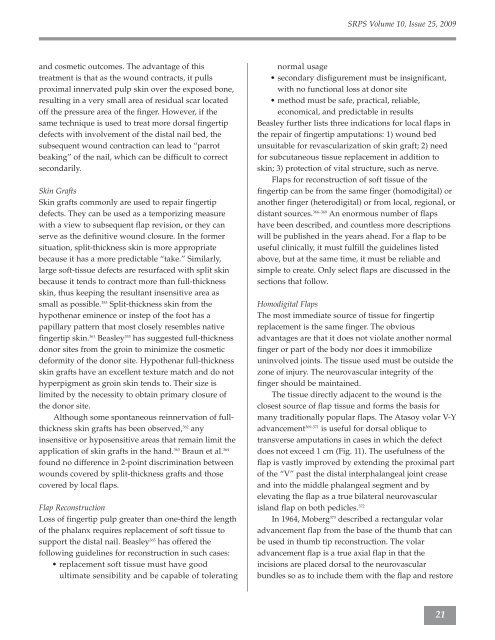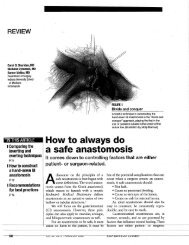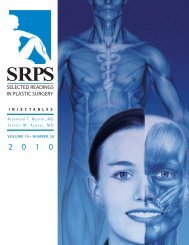SRPS PS - Plastic Surgery Internal
SRPS PS - Plastic Surgery Internal
SRPS PS - Plastic Surgery Internal
You also want an ePaper? Increase the reach of your titles
YUMPU automatically turns print PDFs into web optimized ePapers that Google loves.
and cosmetic outcomes. The advantage of this<br />
treatment is that as the wound contracts, it pulls<br />
proximal innervated pulp skin over the exposed bone,<br />
resulting in a very small area of residual scar located<br />
off the pressure area of the finger. However, if the<br />
same technique is used to treat more dorsal fingertip<br />
defects with involvement of the distal nail bed, the<br />
subsequent wound contraction can lead to “parrot<br />
beaking” of the nail, which can be difficult to correct<br />
secondarily.<br />
Skin Grafts<br />
Skin grafts commonly are used to repair fingertip<br />
defects. They can be used as a temporizing measure<br />
with a view to subsequent flap revision, or they can<br />
serve as the definitive wound closure. In the former<br />
situation, split-thickness skin is more appropriate<br />
because it has a more predictable “take.” Similarly,<br />
large soft-tissue defects are resurfaced with split skin<br />
because it tends to contract more than full-thickness<br />
skin, thus keeping the resultant insensitive area as<br />
small as possible. 353 Split-thickness skin from the<br />
hypothenar eminence or instep of the foot has a<br />
papillary pattern that most closely resembles native<br />
fingertip skin. 361 Beasley 353 has suggested full-thickness<br />
donor sites from the groin to minimize the cosmetic<br />
deformity of the donor site. Hypothenar full-thickness<br />
skin grafts have an excellent texture match and do not<br />
hyperpigment as groin skin tends to. Their size is<br />
limited by the necessity to obtain primary closure of<br />
the donor site.<br />
Although some spontaneous reinnervation of fullthickness<br />
skin grafts has been observed, 362 any<br />
insensitive or hyposensitive areas that remain limit the<br />
application of skin grafts in the hand. 363 Braun et al. 364<br />
found no difference in 2-point discrimination between<br />
wounds covered by split-thickness grafts and those<br />
covered by local flaps.<br />
Flap Reconstruction<br />
Loss of fingertip pulp greater than one-third the length<br />
of the phalanx requires replacement of soft tissue to<br />
support the distal nail. Beasley 365 has offered the<br />
following guidelines for reconstruction in such cases:<br />
replacement soft tissue must have good<br />
ultimate sensibility and be capable of tolerating<br />
<strong>SR<strong>PS</strong></strong> Volume 10, Issue 25, 2009<br />
normal usage<br />
secondary disfigurement must be insignificant,<br />
with no functional loss at donor site<br />
method must be safe, practical, reliable,<br />
economical, and predictable in results<br />
Beasley further lists three indications for local flaps in<br />
the repair of fingertip amputations: 1) wound bed<br />
unsuitable for revascularization of skin graft; 2) need<br />
for subcutaneous tissue replacement in addition to<br />
skin; 3) protection of vital structure, such as nerve.<br />
Flaps for reconstruction of soft tissue of the<br />
fingertip can be from the same finger (homodigital) or<br />
another finger (heterodigital) or from local, regional, or<br />
distant sources. 366–369 An enormous number of flaps<br />
have been described, and countless more descriptions<br />
will be published in the years ahead. For a flap to be<br />
useful clinically, it must fulfill the guidelines listed<br />
above, but at the same time, it must be reliable and<br />
simple to create. Only select flaps are discussed in the<br />
sections that follow.<br />
Homodigital Flaps<br />
The most immediate source of tissue for fingertip<br />
replacement is the same finger. The obvious<br />
advantages are that it does not violate another normal<br />
finger or part of the body nor does it immobilize<br />
uninvolved joints. The tissue used must be outside the<br />
zone of injury. The neurovascular integrity of the<br />
finger should be maintained.<br />
The tissue directly adjacent to the wound is the<br />
closest source of flap tissue and forms the basis for<br />
many traditionally popular flaps. The Atasoy volar V-Y<br />
advancement 369-371 is useful for dorsal oblique to<br />
transverse amputations in cases in which the defect<br />
does not exceed 1 cm (Fig. 11). The usefulness of the<br />
flap is vastly improved by extending the proximal part<br />
of the “V” past the distal interphalangeal joint crease<br />
and into the middle phalangeal segment and by<br />
elevating the flap as a true bilateral neurovascular<br />
island flap on both pedicles. 372<br />
In 1964, Moberg 373 described a rectangular volar<br />
advancement flap from the base of the thumb that can<br />
be used in thumb tip reconstruction. The volar<br />
advancement flap is a true axial flap in that the<br />
incisions are placed dorsal to the neurovascular<br />
bundles so as to include them with the flap and restore<br />
21






